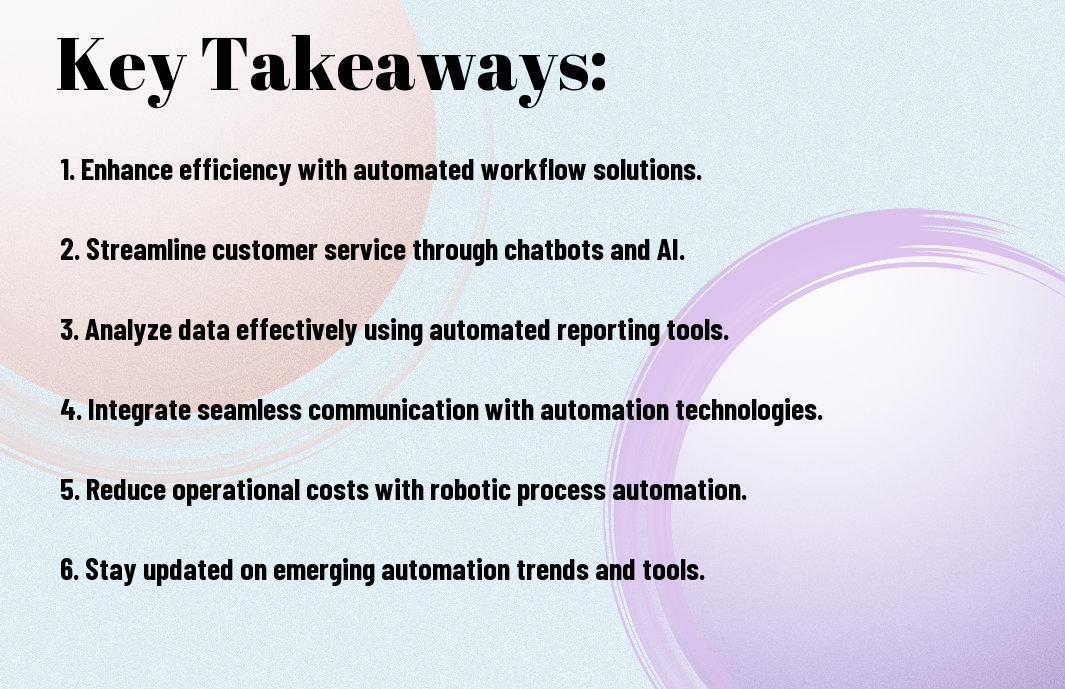Just as technology continues to reshape the business landscape, you must stay informed about the latest automation trends to maintain your competitive edge. In this blog post, we’ll explore seven crucial guides that probe into the practical applications of automation for businesses in 2025. These resources will equip you with the insights and strategies needed to streamline operations, enhance productivity, and optimize customer experiences. Equip yourself with knowledge that can transform the way you work and elevate your business to new heights.
Key Takeaways:
- Embrace AI technologies to streamline operations and improve productivity across various business functions.
- Utilize data analytics for informed decision-making, enhancing customer experiences and operational efficiencies.
- Invest in employee training to ensure teams are equipped to work alongside automated systems effectively.
- Focus on integrating automation solutions that are scalable and adaptable to future business needs.
- Keep up with emerging trends and innovations in automation technology to stay competitive in your industry.


The Rise of Automation in Business
Before you research into the future landscape of entrepreneurship, it’s vital to understand the trajectory of automation. Businesses are increasingly leveraging automation to enhance productivity, streamline operations, and reduce costs. For insights on this transformative trend, check out Automation in 2025: 10 articles to read now.
Historical Context
Before the current era of automation, businesses relied heavily on manual operations, which often led to inconsistencies and inefficiencies. The evolution from industrial machinery to sophisticated AI systems has set the stage, paving the way for innovative automation strategies that you can now adopt in your business.
Key Drivers of Automation
Rise of advanced technologies and the ever-growing demand for efficiency are major factors driving automation in your business. These trends compel you to seek automated solutions that help meet consumer expectations while lowering operational costs.
Another significant contributor to the rise of automation is the integration of data analytics and artificial intelligence. These technologies empower you to make informed decisions, optimize resource allocation, and ultimately enhance customer experiences. As consumer preferences evolve, understanding these key drivers enables you to stay ahead of the competition and harness the benefits of automation effectively.
Essential Automation Technologies
It’s important to understand the various automation technologies that will shape businesses in the coming years. From Artificial Intelligence to Robotic Process Automation, knowing how to leverage these tools can increase efficiency and streamline operations. For the latest developments, check out the 7 Best Robotic Process Automation Services in 2025.
Artificial Intelligence and Machine Learning
Behind the scenes, Artificial Intelligence (AI) and Machine Learning (ML) are driving significant innovation in automation. These technologies allow systems to analyze data, recognize patterns, and make decisions—enabling your business to improve efficiency and personalize customer interactions.
Robotic Process Automation
One of the most impactful forms of automation in business is Robotic Process Automation (RPA). RPA allows you to automate repetitive tasks by using bots, freeing up your time for more strategic activities.
Automation through RPA can significantly enhance your operational efficiency. By implementing RPA, you can streamline processes such as data entry, invoicing, and report generation. This not only reduces human errors but also allows you to reallocate resources to more value-added tasks. With the right RPA tools in place, you’ll find that your business can achieve faster turnaround times and improved productivity.
Benefits of Implementing Automation
Many businesses are turning to automation to streamline operations and enhance their decision-making capabilities. By adopting automated systems, you can reduce human errors, improve customer satisfaction, and gain a competitive edge. Implementing automation means you can focus on strategic growth while management tasks are handled efficiently. This transformation contributes to a culture of innovation where your team can engage in higher-value activities rather than mundane administrative tasks.
Cost Efficiency
Efficiency is a primary advantage of automation, which can significantly reduce operational costs. By minimizing manual processes, you can save on labor costs and eliminate time wasted in redundant tasks. Automation allows you to allocate resources more effectively, ensuring that your investments yield maximum returns. This leads to overall savings that can be redirected into growth initiatives or new technology.
Enhanced Productivity
Along with reduced costs, automation enhances productivity by enabling faster execution of tasks. With automated systems, you can increase the volume of work completed without compromising quality. Your team will have more time to focus on core business functions, ultimately leading to improved efficiency and effectiveness in workflows. This shift also helps in fostering innovation, as automation frees up mental bandwidth for your team to brainstorm and execute new ideas.
Cost savings realized through automation don’t merely benefit your bottom line but also pave the way for increased productivity. When repetitive tasks are handled by automated solutions, your employees can dedicate their time to high-impact projects that drive your business forward. This not only improves the overall output of your organization but also encourages employee engagement, ensuring that you can harness the full potential of your workforce.
Challenges and Risks
After embracing automation in your business, it’s important to recognize the challenges and risks that come with it. These may include resistance from employees, potential job loss, and the necessity of ongoing training to adapt to new technologies. Balancing efficiency with human touch remains a challenge as you navigate the complexities of automating your business processes.
Job Displacement Concerns
With the rise of automation, you might face valid concerns regarding job displacement within your organization. Employees may worry about their roles being replaced by machines, leading to decreased morale and productivity. As a business leader, it’s important to address these fears and ensure your team understands how automation can enhance, rather than eliminate, human jobs.
Cybersecurity Risks
After implementing automated systems, you may encounter new cybersecurity risks that could jeopardize your business. As automation relies on interconnected digital technologies, vulnerabilities in one area can expose your entire system to threats, such as data breaches or hacking attempts. Ensuring robust security measures is vital to protecting your business’s sensitive information.
Cybersecurity should be a top priority as you incorporate automation into your business practices. The more you automate, the more data flows through your systems, making them prime targets for cybercriminals. Regular risk assessments, employee training, and comprehensive security protocols can help safeguard your business against potential attacks and protect your valuable data.

Case Studies of Successful Automation
Your understanding of automation’s impact can deepen with real-world examples. Numerous businesses have experienced transformative benefits through automation, underscoring its potential. Here’s a detailed list of notable case studies:
- Amazon: Enhanced efficiency with automated warehouses, reducing order processing time by 30%.
- Spotify: Leveraged AI for personalized user recommendations, increasing user engagement by 40%.
- Domino’s Pizza: Integrated chatbots for customer service, resolving 70% of inquiries without human intervention.
- Tesla: Utilized automation in manufacturing, achieving a 20% decrease in production costs.
- Salesforce: Implemented automated workflows, resulting in a 25% reduction in administrative tasks for sales teams.
Small Business Examples
Studies reveal that small businesses can significantly benefit from automation. For instance, a local coffee shop automated its inventory management, resulting in a 15% reduction in waste and a 30% increase in operational efficiency. Another small retailer utilized social media automation tools to boost online sales by 50%, illustrating that automation is not just for large enterprises.
Large Enterprise Implementations
To illustrate large enterprise implementations, consider how major corporations are utilizing automation to streamline operations. Companies like Coca-Cola are using real-time data analytics and automated supply chain management, leading to a 10% increase in efficiency across their distribution networks.
It is necessary to note that larger enterprises harness automation on a broad scale, affecting various departments from HR to supply chain management. For instance, General Electric employs predictive maintenance systems in manufacturing, reducing downtime by 30%. Such implementations reflect a growing trend in which enterprises are integrating advanced automation technologies to foster agile, data-driven decision-making processes, ultimately enhancing overall business performance.
Future Trends in Business Automation
Once again, the landscape of business automation is experiencing a seismic shift, preparing for a future where efficiency and innovation will dominate. The integration of advanced technologies will redefine how your organization operates, enabling seamless workflows and enhanced productivity. As you navigate these changes, being attuned to future trends will help you stay competitive and capitalize on new opportunities.
Predictions for 2025
By 2025, you can expect to see a significant increase in the adoption of AI-powered automation tools, enhancing decision-making and processing speed within your business. As organizations prioritize efficiency, chatbots, machine learning, and data analytics will become necessary in streamlining operations and improving customer experiences.
Emerging Technologies to Watch
Among the emerging technologies set to transform your business automation landscape, blockchain, AI, and the Internet of Things (IoT) are leading the charge. These innovations promise to enhance transparency, security, and connectivity, enabling more streamlined, efficient processes across various industries.
At the forefront, blockchain technology will revolutionize your data management, ensuring secure transactions while reducing costs. AI and machine learning will empower your business to analyze vast datasets, driving informed decision-making and personalization in customer interactions. Meanwhile, IoT devices will create interconnected networks within your operations, allowing for real-time monitoring and analysis that can lead to significant improvements in productivity. Staying informed about these technologies will be instrumental in your business’s future success.
Final Words
As a reminder, adopting automation in your business is not just a trend; it’s a necessary evolution for staying competitive in 2025 and beyond. The guides highlighted in this article provide you with imperative insights to help streamline your operations and enhance productivity. By understanding the key components of automation, you can effectively implement strategies that will benefit your organization now and in the future. Stay informed, adapt to new technologies, and position your business for sustainable growth in an automated world.
FAQ
Q: What is the significance of automation in business for 2025?
A: Automation is set to transform businesses by enhancing operational efficiency, reducing human errors, and cutting costs. In 2025, businesses adopting automation tools will likely see improved productivity, faster decision-making processes, and better resource management, driving competitive advantage in the market.
Q: Which industries are expected to benefit most from automation in 2025?
A: Several industries are poised to gain from automation, including manufacturing, healthcare, retail, and finance. Sectors that rely heavily on repetitive tasks and data handling are already implementing automated systems, while industries that embrace innovation will continue to seek effective automation solutions in 2025.
Q: What types of automation tools should businesses consider implementing by 2025?
A: Businesses should explore various automation tools, including Robotic Process Automation (RPA) for repetitive tasks, artificial intelligence for data analysis and customer interactions, and workflow automation software for project management and operational efficiency. Choosing the right tools depends on business needs and goals.
Q: How can small businesses leverage automation by 2025?
A: Small businesses can adopt automation tools to streamline processes, improve customer engagement, and enhance overall efficiency. Solutions like email marketing automation, chatbots for customer support, and financial software for accounting can help small businesses save time and focus on growth-oriented tasks.
Q: What challenges might businesses face when implementing automation by 2025?
A: While automation offers numerous advantages, businesses may face challenges such as integration issues with existing systems, resistance from employees fearing job displacement, and the initial costs of implementing new technologies. Developing a clear strategy and addressing employee concerns can mitigate these challenges.
Q: How does automation affect job roles within a company?
A: Automation may change the nature of job roles within a company rather than eliminate them. Certain repetitive tasks may be automated, allowing employees to focus on higher-value work, such as strategic decision-making and creative problem-solving. Upskilling and reskilling employees will be imperative to adapt to these changes.
Q: Where can businesses find reliable resources about automation trends for 2025?
A: Businesses can access various resources to stay informed about automation trends, including industry reports, online courses, webinars, and publications from technology firms. Websites specializing in business technology and automation, as well as thought leadership blogs, are also valuable sources of information for ongoing education.
